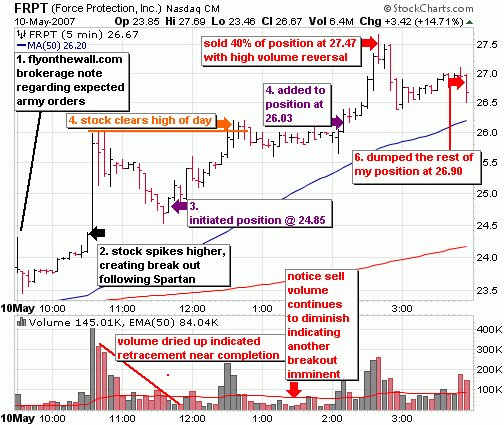Tuesday, February 07, 2012 9:01:56 PM
IAMLEGEND LESSON OF THE DAY!!! ~CHASING STOCKS~

~~link back for previous lessons~~
Chasing' refers to raising your buying price rapidly in a desperate effort to get the shares. Most of the time this is a very bad idea. When a stock starts running your emotions will try to take over, a tendency that must be overcome. Other chasers will eventually have their orders filled and buying pressure will drop, leaving the price to follow suit. If, by chance, you miss a big run, try not to worry about it. Remember that stocks virtually never go straight up, and by not chasing you are greatly reducing your risk of a loss. If you absolutely have to get in, and you are confident the run has more steam, try not to chase much more than 5%. Set your entry price and stick to it. Let the price come to you.
"Buy into weakness, Sell into Strength"
-Instead of chasing a stock, you should be buying it when it's down. The saying for success is: "Buy into weakness, Sell into strength". This is, of course, if you truly believe the stock to be a winner. A good stock will almost always look the gloomiest right before it rebounds. Smart money is adding on the dips, selling near the peaks. Dumb money is chasing up the peak, and selling into the dip. Experienced traders thrive on dumb money, they are essentially collecting it for themselves...

VIDEO ON TRADING RULES
~~ 10 RULES/TIPS ~~

1.Always use limit orders when getting into a stock. Pick an entry price and stick with it.
2.Never use market orders to enter into a trade. Using market orders allows the market maker to fill you at whatever price they like and leaves you vulnerable to getting poor fills.
3.IF A STOCK GAPS WAY UP DO NOT CHASE IT. Most stocks that gap up will come down during the day. (usually starting between 9:45 EST and 10:15 EST) When a stock gaps up the market makers will usually push it lower starting at this time to try to get investors to panic and sell shares back to them so they can make a profit on any shares they are short from filling orders on the gap. If you like the stock and it gaps up you can usually pick up cheaper shares when the market settles back.
4.Watching the open is very important. You can learn a lot about how a stock may act in the first 10-15 minutes after the market opens.
5.The first thing I look for is lots of selling. If you are watching a stock that has an average daily volume of 50,000 shares and the stock trades 250,000 shares in the first ten minutes and it isn't moving this is not a good sign. This means there are lots of sellers and they are probably only going to get more aggressive as the day goes on.
6.Every big loss started as a small loss where the investor lost control of their emotions and didn't close out the trade. When you're an investor you are going to have trades that go against you. It happens to everyone. Successful traders know how to limit losses while unsuccessful ones do not. They begin to hope and pray that the stock will turn around so they don't lose money and next thing they know a small 10% loss is now a 40% loss. At this point they begin to think the stock cannot go any lower and they hang on.
7. STOP Loss Order. These orders are put below the current market and are triggered when a stock is on the way down. A stop loss order is designed to limit your loss or protect your profits on a trade.
THE BEST PLACE TO PUT YOUR STOPS IS JUST BELOW THE PREVIOUS DAYS CLOSE. THIS IS ALSO THE PRICE I MENTION IN MY ALERTS. STOPS SHOULD BE KEPT TIGHT TO LIMIT LOSSES. 10%-20% MAX.
8.There is nothing wrong with taking 10%, 15%, or 20% profits on trades. This gets you in a winning state of mind and makes taking profits much more of a habit. You do not need to buy at every low and sell at every high in order to make a lot of money in the market. You just need to be consistent.
9.TRAILING STOPS You should always use trailing stops to protect your profits after a stock has gone higher. For example if you get into a stock at .10 cents and it runs up to .20 cents you want to protect your profits. Some people will decide to get out completely and that's smart but some of you may want to stay in the trade to see if it goes higher. The best way to do this is to use a trailing stop. In my example your stop may be .18 cents which means if the stock comes down off .20 cents and gets to .18 cents your stock is sold. This protects your profits. A mistake that many traders make is allowing a profitable trade to turn into a break even or losing trade. Don't let this happen to you. Use trailing stops. If the stock continues to move up you move your trailing stop up with it to continue to protect profits as you go.
10.Always book profits no matter how small. Put the money in the bank.TAKE THE MONEY AND RUN

~~link back for previous lessons~~
Chasing' refers to raising your buying price rapidly in a desperate effort to get the shares. Most of the time this is a very bad idea. When a stock starts running your emotions will try to take over, a tendency that must be overcome. Other chasers will eventually have their orders filled and buying pressure will drop, leaving the price to follow suit. If, by chance, you miss a big run, try not to worry about it. Remember that stocks virtually never go straight up, and by not chasing you are greatly reducing your risk of a loss. If you absolutely have to get in, and you are confident the run has more steam, try not to chase much more than 5%. Set your entry price and stick to it. Let the price come to you.
"Buy into weakness, Sell into Strength"
-Instead of chasing a stock, you should be buying it when it's down. The saying for success is: "Buy into weakness, Sell into strength". This is, of course, if you truly believe the stock to be a winner. A good stock will almost always look the gloomiest right before it rebounds. Smart money is adding on the dips, selling near the peaks. Dumb money is chasing up the peak, and selling into the dip. Experienced traders thrive on dumb money, they are essentially collecting it for themselves...

VIDEO ON TRADING RULES
~~ 10 RULES/TIPS ~~
1.Always use limit orders when getting into a stock. Pick an entry price and stick with it.
2.Never use market orders to enter into a trade. Using market orders allows the market maker to fill you at whatever price they like and leaves you vulnerable to getting poor fills.
3.IF A STOCK GAPS WAY UP DO NOT CHASE IT. Most stocks that gap up will come down during the day. (usually starting between 9:45 EST and 10:15 EST) When a stock gaps up the market makers will usually push it lower starting at this time to try to get investors to panic and sell shares back to them so they can make a profit on any shares they are short from filling orders on the gap. If you like the stock and it gaps up you can usually pick up cheaper shares when the market settles back.
4.Watching the open is very important. You can learn a lot about how a stock may act in the first 10-15 minutes after the market opens.
5.The first thing I look for is lots of selling. If you are watching a stock that has an average daily volume of 50,000 shares and the stock trades 250,000 shares in the first ten minutes and it isn't moving this is not a good sign. This means there are lots of sellers and they are probably only going to get more aggressive as the day goes on.
6.Every big loss started as a small loss where the investor lost control of their emotions and didn't close out the trade. When you're an investor you are going to have trades that go against you. It happens to everyone. Successful traders know how to limit losses while unsuccessful ones do not. They begin to hope and pray that the stock will turn around so they don't lose money and next thing they know a small 10% loss is now a 40% loss. At this point they begin to think the stock cannot go any lower and they hang on.
7. STOP Loss Order. These orders are put below the current market and are triggered when a stock is on the way down. A stop loss order is designed to limit your loss or protect your profits on a trade.
THE BEST PLACE TO PUT YOUR STOPS IS JUST BELOW THE PREVIOUS DAYS CLOSE. THIS IS ALSO THE PRICE I MENTION IN MY ALERTS. STOPS SHOULD BE KEPT TIGHT TO LIMIT LOSSES. 10%-20% MAX.
8.There is nothing wrong with taking 10%, 15%, or 20% profits on trades. This gets you in a winning state of mind and makes taking profits much more of a habit. You do not need to buy at every low and sell at every high in order to make a lot of money in the market. You just need to be consistent.
9.TRAILING STOPS You should always use trailing stops to protect your profits after a stock has gone higher. For example if you get into a stock at .10 cents and it runs up to .20 cents you want to protect your profits. Some people will decide to get out completely and that's smart but some of you may want to stay in the trade to see if it goes higher. The best way to do this is to use a trailing stop. In my example your stop may be .18 cents which means if the stock comes down off .20 cents and gets to .18 cents your stock is sold. This protects your profits. A mistake that many traders make is allowing a profitable trade to turn into a break even or losing trade. Don't let this happen to you. Use trailing stops. If the stock continues to move up you move your trailing stop up with it to continue to protect profits as you go.
10.Always book profits no matter how small. Put the money in the bank.TAKE THE MONEY AND RUN
Join the InvestorsHub Community
Register for free to join our community of investors and share your ideas. You will also get access to streaming quotes, interactive charts, trades, portfolio, live options flow and more tools.










